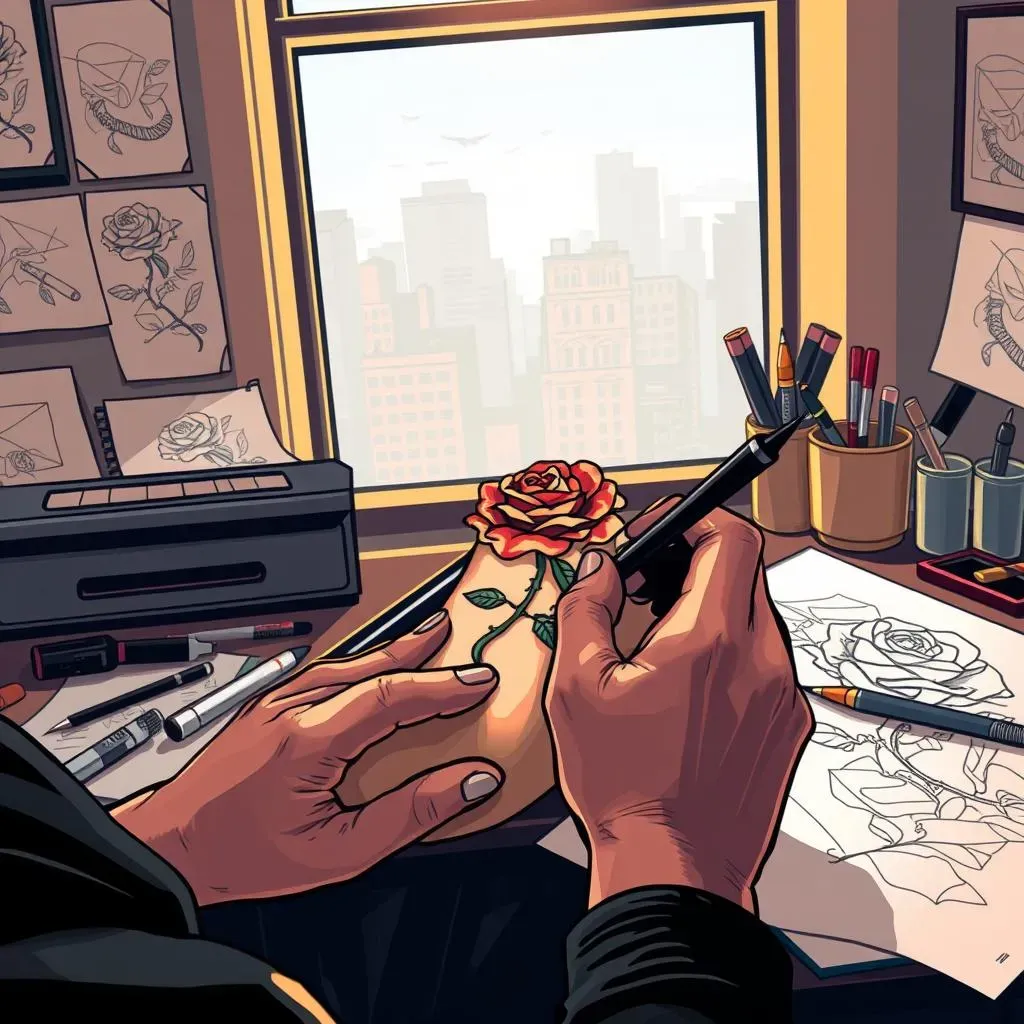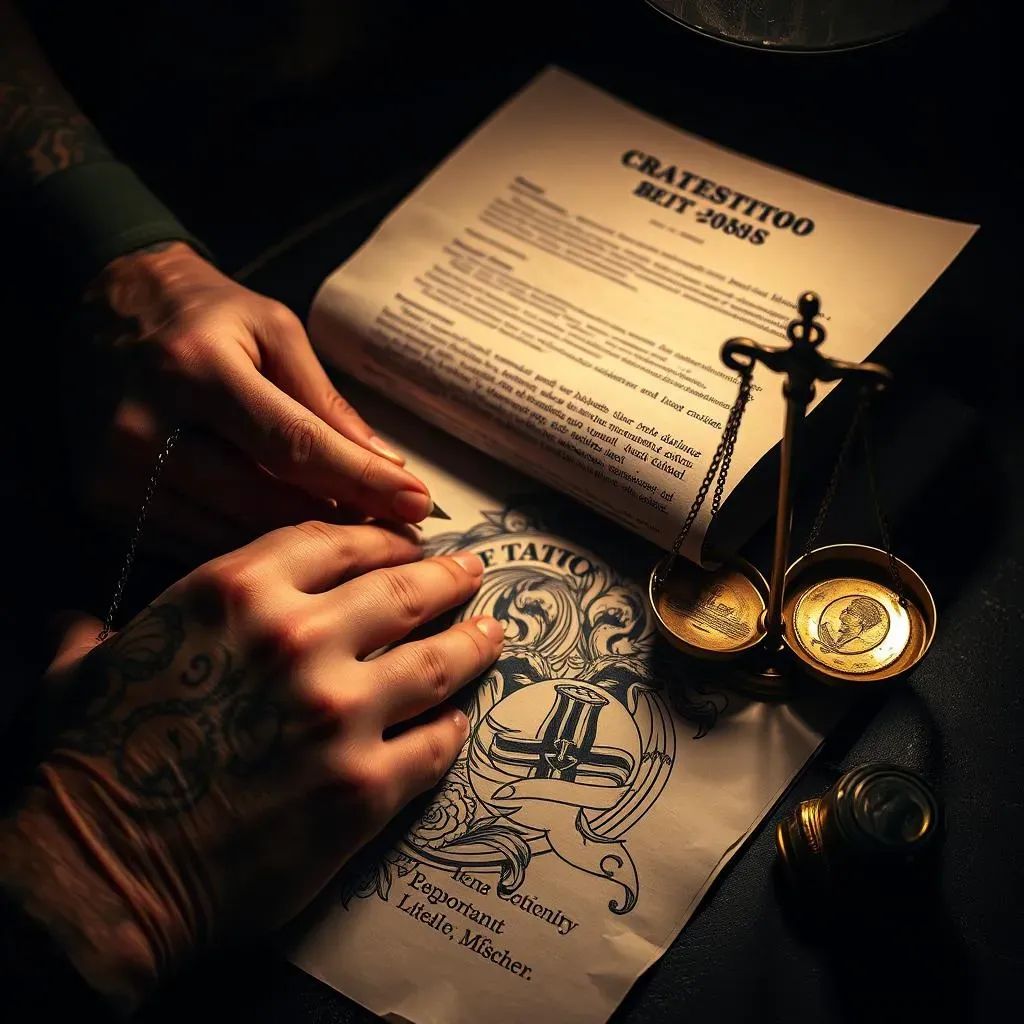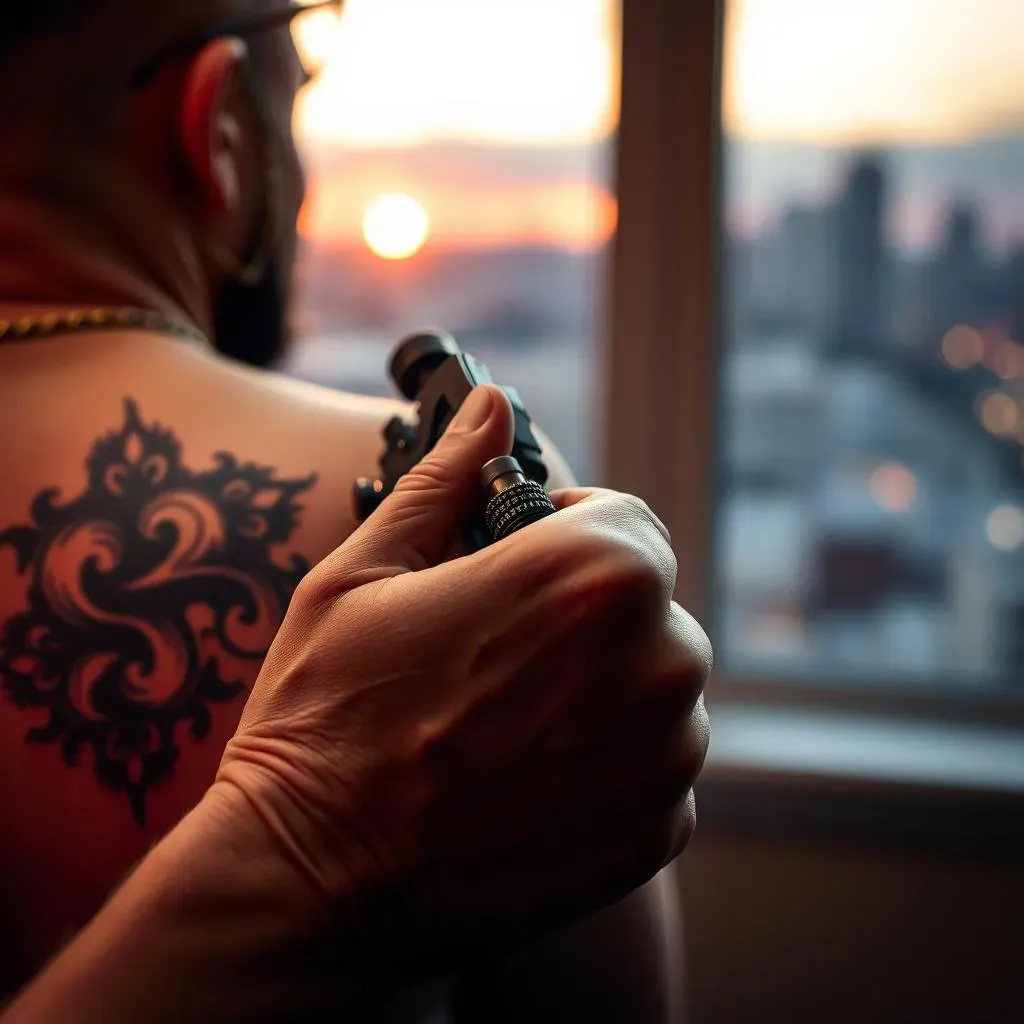Table of Contents
Ever wondered who owns the rights to that incredible piece of art inked on your skin? The world of tattoo art is a fascinating blend of creativity, personal expression, and legal considerations. At the heart of it all lies a crucial question: do tattoo artists own their designs? It's a question that navigates the complex intersection of copyright law and artistic creation, impacting both the artists who wield the needles and the clients who proudly display their work. This article dives deep into the realm of tattoo copyright, exploring the rights of tattoo artists, the extent of client ownership, and the potential pitfalls of copyright infringement in the tattoo world. We'll unravel the nuances of implied licenses, work-for-hire agreements, and what happens when existing artwork finds its way onto skin. Whether you're an artist seeking to protect your creations or a client curious about your rights, prepare to navigate the intricate legal landscape that governs the ownership of tattoo designs.
Copyright Protection: Who Owns Tattoo Designs?
Copyright Protection: Who Owns Tattoo Designs?
The Basics of Tattoo Copyright
Let's get straight to the point: original tattoo designs are absolutely eligible for copyright protection. Think of a tattoo design like any other piece of art – a painting, a sculpture, or a digital illustration. If it's original and fixed in a tangible medium (in this case, skin), it's protected by copyright law. This means the artist who created the design generally holds the copyright. They have the exclusive right to reproduce, distribute, and create derivative works based on their design. It's kind of wild to think about, but that intricate dragon winding down your arm is essentially intellectual property!
But what does "original" really mean in the tattoo world? It means the design wasn't copied from someone else's work. Now, inspiration is everywhere, and tattoo artists often draw from existing imagery or styles. However, the final design must have a unique and creative flair to qualify for copyright protection. So, a simple heart might not cut it, but a heart intertwined with a banner featuring a custom font and unique flourishes? That's more likely to be considered original.
The Tattoo Artist as Copyright Holder
Generally, the tattoo artist is considered the author of the tattoo design and, therefore, the initial copyright holder. This makes sense, right? They're the ones who put in the creative work, translating an idea into a visual reality on skin. The law sees them as the creator, just like a painter is the creator of their painting. But there are exceptions, which we'll get into later, such as work-for-hire agreements.
However, it's important to understand that copyright doesn't protect the *idea* of a tattoo. It protects the specific *expression* of that idea. Anyone can get a tattoo of a rose, but a specific, unique rose design created by an artist is protected. This distinction is crucial. It allows for creative freedom while still safeguarding artists' original work.
Implied License: What Clients Can (and Can't) Do
So, you've got a killer tattoo. Can you take pictures of it? Show it off? Of course! That's where the concept of an implied license comes in. When you get a tattoo, there's an implied agreement between you and the artist that you have the right to display your tattoo publicly. This is pretty straightforward – tattoos are meant to be seen!
However, this implied license has limits. It generally doesn't extend to reproducing the tattoo design for commercial purposes. For example, you can't print your tattoo on t-shirts and sell them without the artist's permission. That would be infringing on their copyright. The implied license is for personal display, not commercial exploitation. It's a balance between the client's right to enjoy their tattoo and the artist's right to control their creative work.
Action | Permitted Under Implied License? |
|---|---|
Displaying the tattoo in public | Yes |
Taking photos of the tattoo | Yes |
Sharing photos on social media | Yes |
Printing the tattoo on merchandise for sale | No |
Creating derivative artwork based on the tattoo | No |
Client Input and Tattoo Design Ownership Rights
Client Input and Tattoo Design Ownership Rights
The Idea vs. The Execution
Let's talk about collaboration. What happens when you, as the client, bring a ton of ideas to the table? Maybe you've got a specific vision in mind, or you've pieced together elements from different images. Does that mean you automatically own the copyright to the final tattoo? Not necessarily. While your input is valuable and shapes the direction of the design, copyright usually hinges on the artist's execution. It's their skill, creativity, and unique artistic choices that transform your ideas into a tangible piece of art. Think of it like commissioning a portrait: you might describe the pose, the clothing, and the background, but the artist still owns the copyright to the painting they create.
However, there's a gray area. If you provide a highly detailed sketch or a near-complete design, the lines can blur. The more original artwork you contribute, the stronger your claim to at least partial ownership might be. But in most cases, the artist's contribution is significant enough to grant them the primary copyright. This highlights the importance of communication and clear agreements between the artist and the client.
To make it simple, here’s a breakdown:
- Client provides a vague idea: Artist likely owns the copyright.
- Client provides detailed instructions: Artist likely owns the copyright, but client input is acknowledged.
- Client provides a near-complete design: Copyright ownership becomes less clear and should be discussed.
Work-for-Hire Agreements in the Tattoo World
Now, let's throw a curveball into the mix: work-for-hire agreements. In certain situations, a tattoo can be considered a "work for hire," where the copyright is automatically assigned to the person who commissioned the work. This is less common in the tattoo world than in, say, graphic design or illustration, but it's still a possibility.
For a tattoo to be considered work-for-hire, there usually needs to be a written agreement explicitly stating that the copyright is being transferred to the client. This agreement should be signed by both the artist and the client before the tattoo is created. Without a written agreement, it's highly unlikely that a tattoo would be considered work-for-hire. These agreements are especially relevant if the tattoo is part of a larger branding or commercial project. For example, a company might commission a tattoo design to be used in an advertising campaign, in which case they'd likely want to own the copyright.
Documenting the Creative Process
Regardless of who ultimately owns the copyright, it's always a good idea to document the creative process. Artists should keep sketches, notes, and any other materials that demonstrate their artistic contribution. Clients should retain copies of any designs or instructions they provided. This documentation can be invaluable if a copyright dispute ever arises. It provides evidence of who contributed what to the final design, making it easier to determine ownership.
Moreover, clear communication is key. Before the tattoo process begins, artists and clients should discuss copyright ownership and any potential restrictions on the use of the design. A simple written agreement, even if it's not a formal work-for-hire contract, can help prevent misunderstandings and protect both parties' interests. It's all about setting expectations and ensuring everyone is on the same page.
Action | Recommendation |
|---|---|
Artist creates original design | Document sketches, notes, and inspiration sources. |
Client provides input or design elements | Retain copies of all provided materials. |
Both parties collaborate on the design | Document the collaborative process and agreements made. |
Navigating Copyright Infringement in Tattoo Art
Navigating Copyright Infringement in Tattoo Art
Tattooing Existing Artwork: A Risky Move
so you're a tattoo artist, and a client walks in wanting a perfect replica of Van Gogh's "Starry Night" on their back. Sounds cool, right? Maybe not so much from a legal standpoint. Tattooing existing artwork, like paintings, illustrations, or even other tattoos, without permission can land you in hot water. That's because you're essentially reproducing someone else's copyrighted work on skin. Even if you make slight modifications, it could still be considered copyright infringement if the original work is recognizable. It's a slippery slope, and it's always best to err on the side of caution.
Think of it this way: you wouldn't photocopy a page from a book and sell it without the author's permission, would you? Tattooing someone else's art is essentially the same thing. The artist holds the copyright to their original work, and you need their permission to reproduce it, even in tattoo form. This doesn't mean you can't be inspired by other artists, but you need to create something new and original, not a direct copy. When in doubt, reach out to the original artist and ask for permission. It's always better to be safe than sorry.
The Mike Tyson Tattoo Case: A Cautionary Tale
Remember Mike Tyson's iconic tribal tattoo around his eye? Well, that tattoo became the center of a copyright lawsuit in 2011. The tattoo artist, Victor Whitmill, sued Warner Bros. for featuring the tattoo prominently in the movie "The Hangover Part II." Whitmill argued that Warner Bros. had infringed on his copyright by reproducing the tattoo without his permission. The case was eventually settled out of court, but it sent a clear message: tattoos are subject to copyright, and unauthorized reproduction can have legal consequences.
This case is a great example of how copyright law applies to tattoos in unexpected ways. It wasn't just about tattooing the design on someone's skin; it was about reproducing that design in a commercial film. The fact that the tattoo was on a celebrity's face didn't change the legal principles involved. It highlighted the importance of tattoo artists protecting their work and the potential for copyright infringement in various media. The Mike Tyson tattoo case serves as a reminder that copyright law is relevant even when tattoos become widely recognized or associated with a particular individual.
Case | Issue | Outcome |
|---|---|---|
Mike Tyson Tattoo Case | Copyright infringement of tattoo design in "The Hangover Part II" | Settled out of court |
(Hypothetical) Tattoo artist copies another's design | Direct copyright infringement of the original tattoo design | Potential lawsuit and damages |
Photographing Tattoos: Permission is Key
Let's say you're a photographer, and you're shooting a portrait of someone with a stunning tattoo. Can you freely use that photo for commercial purposes? Again, it depends. While you own the copyright to the photograph itself, the tattoo artist still owns the copyright to the tattoo design. This means you might need to get permission from the tattoo artist to use the photo commercially, especially if the tattoo is a prominent feature of the image. This is especially true if the tattoo design is particularly unique or recognizable.
The legal landscape around photographing tattoos is still evolving, and there's no definitive answer in every situation. However, it's generally a good idea to get permission from the tattoo artist if you plan to use the photo for commercial purposes. This shows respect for their creative work and helps avoid potential copyright issues. You can also consider blurring or obscuring the tattoo in the photo if you're unable to obtain permission. It's all about striking a balance between artistic expression and respecting intellectual property rights.
Protecting Tattoo Artists' Rights to Their Designs
Protecting Tattoo Artists' Rights to Their Designs
Copyright Registration: Making it Official
So, you're a tattoo artist, pouring your heart and soul into these incredible designs. How do you really solidify your ownership and protect your hard work? The answer is copyright registration. It's like putting a legal fence around your creations. Registering your tattoo designs with the U.S. Copyright Office gives you a significant leg up if you ever need to defend your rights in court. It creates a public record of your ownership and allows you to sue for statutory damages and attorney's fees if someone infringes on your copyright. Think of it as an insurance policy for your art.
The process isn't too complicated, but it does require some paperwork and a small fee. You'll need to submit an application, a copy of your design, and the registration fee to the Copyright Office. Once your registration is approved, you'll receive a certificate of registration, which serves as official proof of your copyright. It's a step that every serious tattoo artist should consider taking to safeguard their creative legacy. Plus, it sends a clear message to potential infringers that you're serious about protecting your work.
Contracts and Client Agreements: Setting Clear Expectations
Beyond copyright registration, clear contracts and client agreements are essential tools for protecting your rights as a tattoo artist. These agreements should outline the terms of the tattoo commission, including who owns the copyright to the design, how the client is allowed to use the tattoo, and any restrictions on its reproduction. A well-written contract can prevent misunderstandings and provide a clear legal framework for the tattoo process.
Your client agreement should address key issues such as:
- Copyright ownership: Clearly state who owns the copyright to the tattoo design.
- Usage rights: Define how the client can use the tattoo (e.g., personal display, social media).
- Restrictions: Specify any restrictions on reproducing the tattoo for commercial purposes.
- Modifications: Address whether the client can modify the tattoo design in the future.
- Photo usage: Outline how the artist can use photos of the tattoo for their portfolio or advertising.
Having these things laid out in writing from the start can save a lot of headaches down the road.
Contract Clause | Purpose |
|---|---|
Copyright Ownership | Defines who owns the copyright to the tattoo design. |
Usage Rights | Specifies how the client can use the tattoo. |
Restrictions | Outlines any limitations on reproducing the tattoo. |
Due Diligence: Know the Origin of Your Designs
As a tattoo artist, it's not enough to just protect your own original designs; you also need to be careful not to infringe on the copyrights of others. Before you start tattooing a design, take the time to research its origins. Is it based on existing artwork? If so, do you have permission from the original artist to use it? Doing your due diligence can help you avoid potential copyright lawsuits.
This means checking online databases, contacting the original artists, and being wary of designs that seem too similar to existing works. It's also a good idea to educate your clients about copyright law and the importance of using original designs. By taking these steps, you can help create a culture of respect for intellectual property in the tattoo community. Remember, a little research can go a long way in preventing legal trouble. It's about respecting other artists and ensuring that you're only tattooing designs that you have the right to use.
Conclusion: Navigating the Ink and Copyright Landscape
The world of tattoos exists where art meets skin, and as we've explored, copyright law definitely applies. While tattoo artists generally hold the rights to their original designs, it's a nuanced area with considerations like client input, implied licenses, and the ever-present risk of infringement. Understanding these aspects is crucial for both artists and clients to ensure creative work is respected and protected. By being aware of copyright principles and proactively establishing clear agreements, everyone can navigate the ink and copyright landscape with confidence, fostering a vibrant and legally sound tattoo community.